Präsentation 2023-03-03#
Terminologie und Ontologie: WordNet trifft SKOS
Prof. Dr. Johannes Busse, HAW Landshut
Freitag, 3. März 2023, 11:30 – 12:00
Über diese Präsentation:
online: jbusse.de/dtt2023 -> Präsentation 2023-03-03
kein ppt, sondern eine statische html-Website, konsistent verlinkt
Cross-Media publishing
Aufsatz und Präsentation nicht als Senke, sondern offener Quelltext in Markdown: http://jbusse.de/dtt2023/_sources/praesentation.md
weiterführende Inhalte: Inhaltliche Ergänzungen
Zusammenfassung#
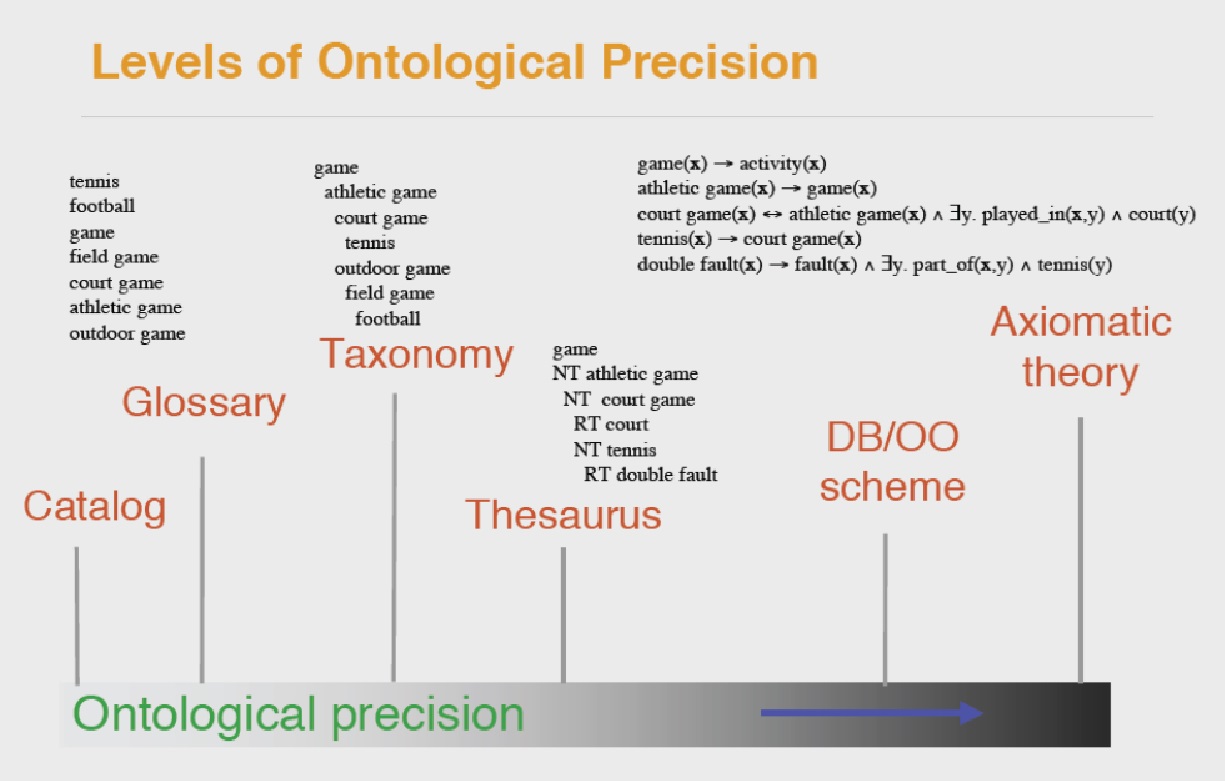
Fig. 6 TBD #
Quelle: Guarino 2006, entnommen aus ISKO Biagetti 2021
Controlled vocabularies solve the problems of homographs, synonyms and polysemes by a bijection between concepts and preferred terms. https://en.wikipedia.org/wiki/Controlled_vocabulary
Man sieht hier waagrecht: Verfeinerung einer Tennis-Terminologie
Catalog: Liste von Wörtern
Glossar: … mit normalsprachlichen Definitionen; 1:1 - Entsprechung zwischen Term und Konzept
Taxonomie: … UNKLAR, Thematisierung später
Thesaurus: Konzepte stehen im Fokus, hierarchische und semantische Relationen, SKOS
Datenbank-, objektorientiertes Schema
axiomatische Theorie = Ontologie = formale Logik!
Auch denkbar: Wechsel der Ebenen:
Thesaurus beschreibt Gegenstands-Konzepte, wie hier Tennis oder im folgenden Schnitzel
Ontologie beschreibt die Thesaurus-Konzepte wie
NToderRT, die die Gegenstands-Konzepte ordnen.
In dieser Abbildung nicht enthalten: WordNet (s.u.)
Einführendes Beispiel#
prefix cpt: <http://jbusse.de/dtt2023/cpt.html#term->
cpt:Schnitzel
"escalope"@en
"cutlet"@en
"шни́цель"@ru
<Schnitzel BY hat_Herkunft>
cpt:Schweineschnitzel
"pork cutlet"@en
"свино́й шни́цель"@ru
cpt:Kalbschnitzel
"veal cutlet"@en
<Schnitzel BY hat_Zielgruppe>
cpt:Kinderschnitzel
Hier zeigen:
informelle Notation, kann z.B. auch in einer Mindmap gepflegt werden
Selbstwahrnehmung: Angst vor Notation? Unnötig!
Präfix cpt::
Kürzel für
http://jbusse.de/dtt2023/cpt.html#term-Ersetzung: aus
cpt:Schnitzelwird http://jbusse.de/dtt2023/cpt.html#term-Schnitzel .
TBL Linked Data Principles
Use URIs as names for things
Use HTTP URIs so that people can look up those names.
When someone looks up a URI, provide useful information, using the standards (RDF*, SPARQL)
Include links to other URIs. so that they can discover more things.
Quelle: Tim Berners-Lee, https://www.w3.org/DesignIssues/LinkedData
SKOS#
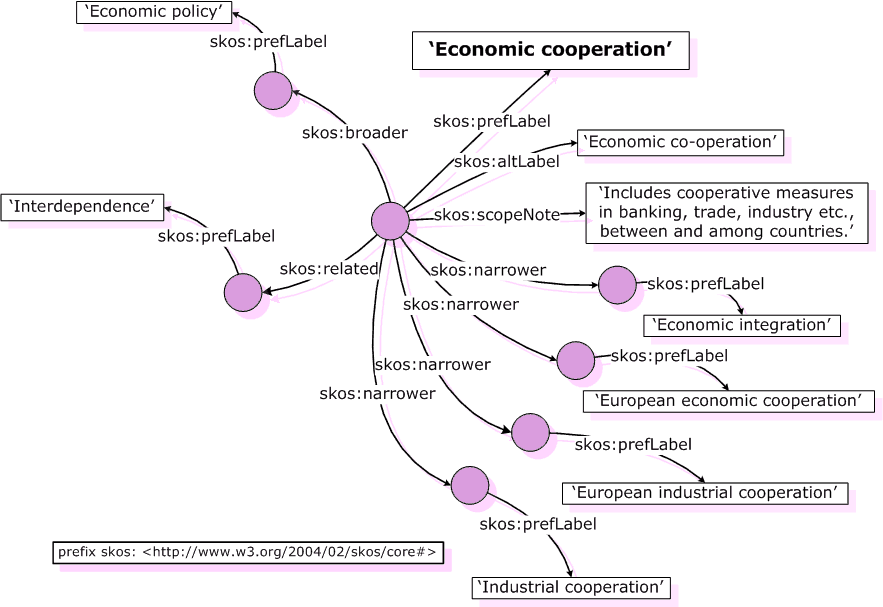
Fig. 7 ‘Economic cooperation’’, aus SKOS Core Guide (2005) #
hier auch RDF erklären:
hier violette runde Knoten: Resources
hier weiße rechteckige Knoten: Literale - und zwar hier Zeichenketten (Strings)
Pfeile: Object- und Data-Properties
skos:narrower, skos:broader: kennen wir aus dem Thesaurus
skos:prefLabel, skos:altLabel: zeigen auf Benennungen, Terme

Fig. 8 ex:love rdf:type skos:Concept#
Quelle: https://www.w3.org/TR/2005/WD-swbp-skos-core-guide-20051102/#secintro
Notieren kann man das in der Sprache Turtle (*.ttl) als ein Tripel:
ex:love rdf:type skos:Concept .
Die Struktur von SKOS#
## Klassen der Ontologie SKOS, TBox
skos:Concept
rdf:type owl:Class .
skos:Collection
rdf:type owl:Class .
skos:ConceptScheme
rdf:type owl:Class .
## Exemplare eines Knowledge Graphs, ABox
ex:Schnitzel
rdf:type skos:Concept .
Immer dann, wenn x BT y zutrifft, trifft automatisch auch y NT x zu:
skos:broader
rdf:type owl:ObjectProperty ;
owl:inverseOf skos:narrower .
skos:narrower
rdf:type owl:ObjectProperty ;
owl:inverseOf skos:broader.
Definition der Properties, mit denen man Benennungen definieren kann:
skos:prefLabel
rdf:type owl:AnnotationProperty
rdfs:domain skos:Concept ;
skos:altLabel
rdf:type owl:AnnotationProperty
rdfs:domain skos:Concept ;
VORISCHT vor Domain und Range: sehr spezielle Semantik!
skos:broader
rdfs:domain skos:Concept ;
rdfs:range skos:Concept .
Mehr: SKOS
WordNet#
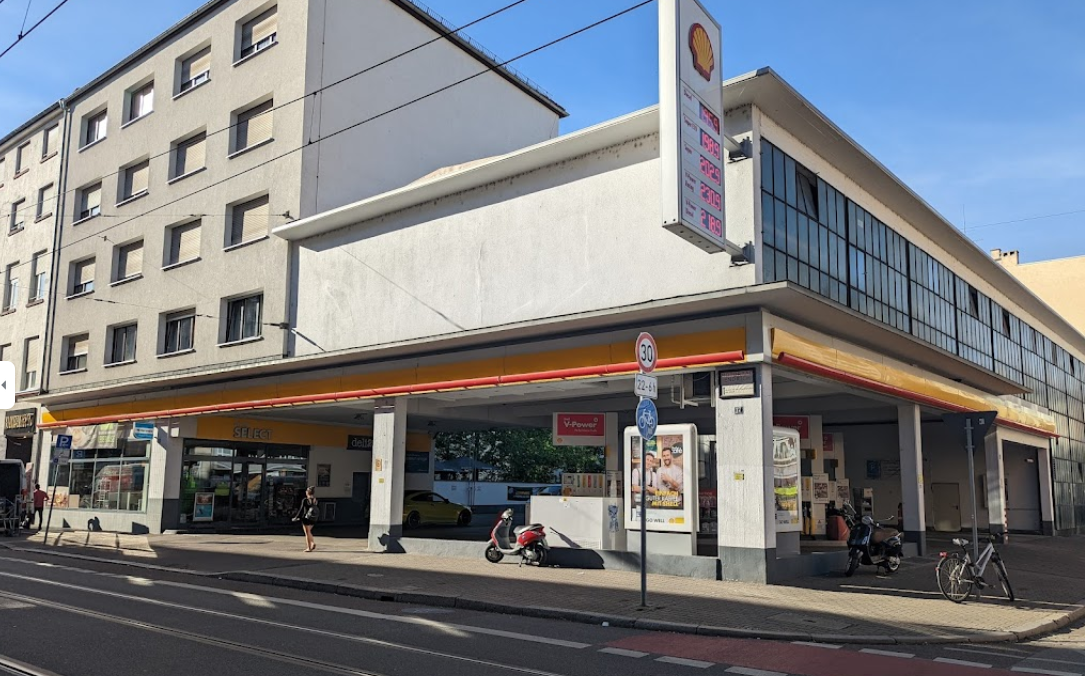
“Our gas station around the corner is open seven days a week, day and night.”
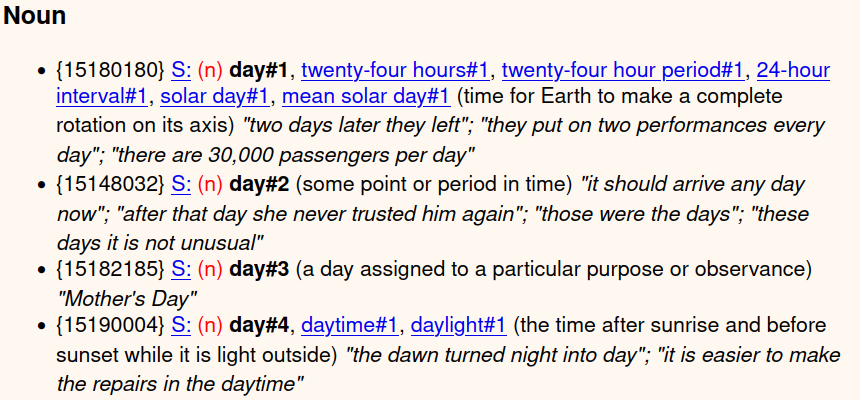
Fig. 9 WordNet > day#
{15180180} S: (n) day#1, twenty-four hours#1, twenty-four hour period#1, 24-hour interval#1, solar day#1, mean solar day#1 (time for Earth to make a complete rotation on its axis) …
Quelle: Princeton WordNet -> Use Wordnet Online > “day”
Synset
The core concept in WordNet is the synset. A synset groups words with a synonymous meaning, such as {car, auto, automobile, machine, motorcar}. Another sense of the word “car” is recorded in the synset {car, railcar, railway car, railroad car}. Although both synsets contain the word “car”, they are different entities in WordNet because they have a different meaning. https://www.w3.org/TR/wordnet-rdf/#wnmetamodel
Synonym, Antonym: besteht zwischen Word Senses
Hypernym (Oberbegriff, skos:broader): besteht zwischen Synsets (!) (https://www.w3.org/TR/wordnet-rdf/#intrown -> “Figure 1. The class hierarchy of the WordNet schema”).
normalsprachliche Erklärung: auch hier auf Synset-Ebene!
Mehr: Wordnet
OntoLex Lemon#
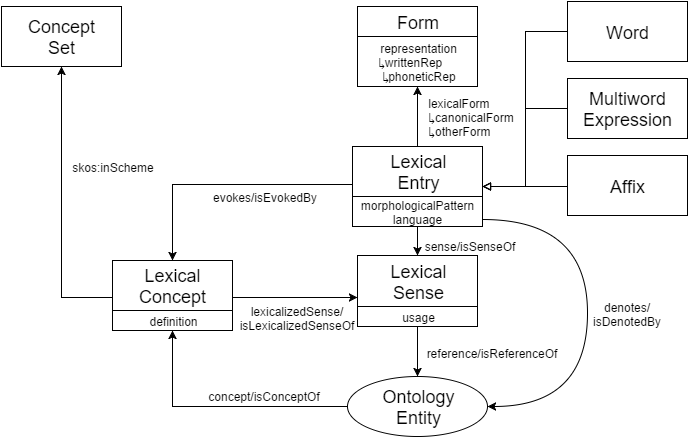
Fig. 10 OntoLex Lemon#
Quelle: https://www.w3.org/2016/05/ontolex/Lemon_OntoLex_Core.png
Mehr: OntoLex-Lemon
Was ist eine Ontologie?#
Gruber 1995 (Hervorhebungen JB):
An ontology is an explicit specification of a conceptualization.
definitions associate the names of entities in the universe of discourse […] with
human-readable text describing what the names mean, and
formal axioms that constrain the interpretation and well-formed use of these terms.
Formally, an ontology is the statement of a logical theory.
Ontologies are typically specified in languages that allow abstraction away from data structures and implementation strategies; in practice, the languages of ontologies are closer in expressive power to first-order logic than languages used to model databases.
Ergebnisse#
SKOS ist eine Ontologie
die mit SKOS erzeugte Struktur ist ein Thesaurus, aber keine Ontologie
subjektive Einschätzung JB
Ontologien sind rocket science.
Einstieg in Terminologie und Ontologie: SKOS ist meistens ausreichend.
WordNet ist anders, als man denkt: Hineindenken lohnt sich!
xxx